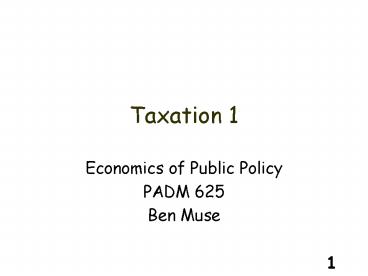Taxation 1 - PowerPoint PPT Presentation
1 / 45
Title:
Taxation 1
Description:
an involuntary payment to the government by an individual or ... payer to a quid pro quo benefit or to an equivalent value of goods and services in exchange. ... – PowerPoint PPT presentation
Number of Views:110
Avg rating:3.0/5.0
Title: Taxation 1
1
Taxation 1
- Economics of Public Policy
- PADM 625
- Ben Muse
2
What is a tax?
- an involuntary payment to the government by an
individual or firm that does not entitle the
payer to a quid pro quo benefit or to an
equivalent value of goods and services in
exchange.
3
Three big taxation issues
- How much revenue will the tax generate?
- Who is going to pay the tax?
- What costs does the tax impose on society
4
Another list of big issues
- Efficiency
- Administrative simplicity
- Flexibility
- Transparency
- Fairness
5
Impact of a lump-sum tax
6
Apples and bagels are the only goods
- Consumer has an income and faces prices for the
two goods - Can draw a budget line
- for simplicity normalize price of a unit of
apples to 1
7
Axes
8
Add a budget constraint
9
Highest indifference curve
10
Lump-sum tax
- Each person pays the same amount
- The amount they pay does not depend in any way on
their behavior - Everyone pays the same using a lump sum tax to
raise all government revenue in 1999 would have
been 10,250 per person - Fairness, practicality issues
11
Lump-sum tax
- The tax reduces each persons income
- This shifts the budget constraint in parallel to
itself - Will decrease the quantities of normal goods
demanded by consumers
12
Effect of lump-sum tax
13
New indifference curve
14
Impact of an excise tax
15
Excise tax
- A tax per unit of a good purchased
- Specific excise tax so many dollars per unit
- Ad valorem a percentage of the purchase price
of the unit - Well be looking at examples of the specific tax
16
Budget constraint
17
Add indifference curve
18
Tax on bagels effectively increases price
19
Original combination
20
New indifference curve
21
New combination
22
Income and substitution effects
- When a price goes up
- There is an income effect - as a person
effectively has less income to spend - and a substitution effect - as a person
substitutes out of the relatively more expensive
good
23
Comparing lump sum and excise taxes
24
A consumers demand curve
25
Consumer faces a price and makes a choice
26
Add a lump sum tax
- As noted above,
- Imposing a lump sum tax on a person
- Will create an income effectand reduce the
amount of the good demanded - at any give price
- this effectively shifts the demand curve to the
left
27
Add a lump sum tax
28
Add an excise tax
- As noted above,
- An excise tax has the effect of increasing the
price for the good - this has the effect of shifting a consumers
demand for the good along the demand curve
29
Add an excise tax
30
Excise tax revenue
- The revenue from the excise tax
- will equal the product of
- the per unit tax
- and the number of units of the good the person
continues to consume after the tax is imposed
31
Excise tax revenue
32
After tax demand curve
- Consumer demand curve wont change
- but demand curve faced by producers does
- The price the producers receive will be less than
the price consumers pay by the amount of the tax
33
Add an excise tax
34
Add the after tax demand curve
35
Excise and lump sum taxes
- If the excise tax raises the same amount of
revenue as the lump sum tax - it will be associated with a larger decrease in
consumption of the good - We are dealing with the substitution effect in
addition to the income effect
36
Add an excise tax
37
Impact on firm decisions
38
Firms decision process
- Firms try to balance marginal costs and
marginal benefits of decisions - Marginal revenue is the additional revenue
associated with a small change in output - If firm faces a constant price (P) its marginal
revenue is equal to the price
39
Firms decision process
- Marginal cost is the additional cost associated
with an small increase in output - We generally assume a firm faces increasing
marginal costs - the cost of an additional unit tends to increase
as output increases
40
Firms decisions
41
Firms decisions
42
Firms decisions
43
Add in an excise tax
- Assume a fixed tax per unit of output
- To be paid by the firm
- This basically is an increase in the firms
marginal cost of producing each unit - Can represent this as an upward shift in marginal
cost curve
44
Firms decisions
45
Source
- Bruce, Chapter 10
- Stiglitz, Joseph. Economics of the Public
Sector. 3d edition. Norton, 2000.































